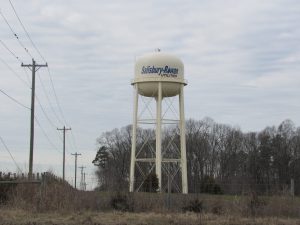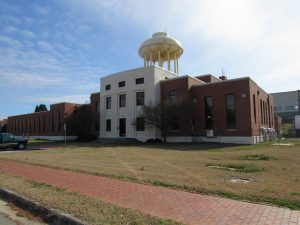
Bigfoot Sighting in Salisbury
By Doug Chapman, PE, Principal / Hickory Office Manager
The following article was originally published in the NC AWWA-WEA’s Spring 2019 edition of NC Currents Magazine.

Salisbury-Rowan Utilities (SRU) operates and maintains water and sewer systems across the City of Salisbury and many other neighboring municipalities within Rowan County. Within the system are 441 miles of water lines, 417 miles of gravity sewer lines, a water treatment plant with raw water reservoir and raw water intake, two wastewater treatment plants with a common discharge, 13 water storage tanks, seven water booster stations, and 34 sewer pumping stations. Over the years, SRU has been very proactive at maintaining infrastructure, including GPS level mapping of all horizontal infrastructure, maintaining equipment and spares for critical elements, updating a system-wide computer-generated water hydraulic model, and regular flushing / cleaning / videoing gravity sewer maintenance system.
SRU sought to further its program of asset inventory and management by utilizing an asset management software to log, track, and monitor the vertical assets in the water and sewer systems, as well as implement a detailed work order system. The challenge of implementing such a system is not the cost of the software but the effort and ultimate cost of capturing all the data and adequately incorporating it into such a software system. To facilitate this effort, SRU applied for and received an Asset Inventory and Assessment (AIA) grant from the North Carolina Division of Water Infrastructure (NCDWI) to fund the project.
 SRU selected McGill Associates and Madrid’s Maintenance Management Solutions as the Project Team to work closely with SRU staff. The team revisited earlier evaluations prepared by SRU of varying software choices. Upon completion of that evaluation, the team determined that the Bigfoot (now Asset Essentials) asset management software was the best fit and application for the goals and objectives of SRU, including vertical asset management, preventive maintenance tracking, and work order documentation.
SRU selected McGill Associates and Madrid’s Maintenance Management Solutions as the Project Team to work closely with SRU staff. The team revisited earlier evaluations prepared by SRU of varying software choices. Upon completion of that evaluation, the team determined that the Bigfoot (now Asset Essentials) asset management software was the best fit and application for the goals and objectives of SRU, including vertical asset management, preventive maintenance tracking, and work order documentation.
The next step involved preparing a detailed inventory of existing equipment. The inventory was developed by making complete site visits to every “vertical” facility, including water tanks, water and sewer pumping stations, water treatment plant, and wastewater treatment facilities. The system inventory added complete nameplate data for all equipment, including manufacturer names, models, serial numbers, and pertinent operating data. To adequately track data, a unique numbering system was established to include equipment numbering and location hierarchy. Further, when equipment is completely replaced, the new item will be given a different numbering identifier to allow for complete and accurate tracking of each piece of equipment within the system whether new, rebuilt, or older.
Following development of the system inventory, the criticality of each piece of equipment was determined. The team determined that criticality would be a sum of two factors – likelihood of failure and consequence of failure. When considering the likelihood of failure, a piece of equipment is evaluated based on its operating conditions, the frequency with which that type of equipment typically fails, and a consideration of historical failure rates within the application. Consequence of failure was established based on the level of consequence and urgency that would be placed on the failure, whether related to environmental consequences, service to customer consequences, and/or detriment to the overall system operations.
 Finally, the condition of each vertical asset was evaluated. This data was compiled in spreadsheets and uploaded into the asset management software. The system was then tested for access and functionality. Following initial testing, training was performed with SRU at various levels. Staff access was divided into levels depending on position use, need, and functionality. Following a software usage period by SRU, a follow-up training session was held to fully acclimate staff to the software capabilities.
Finally, the condition of each vertical asset was evaluated. This data was compiled in spreadsheets and uploaded into the asset management software. The system was then tested for access and functionality. Following initial testing, training was performed with SRU at various levels. Staff access was divided into levels depending on position use, need, and functionality. Following a software usage period by SRU, a follow-up training session was held to fully acclimate staff to the software capabilities.
The asset management software has been fully utilized to track preventive maintenance, regular maintenance, and unscheduled maintenance for assets contained within the system, as well as the critical nature of the submitted work orders. The reports generated from the software provide a myriad of information that can be utilized by management to predict staffing needs, the schedule with which equipment should be replaced, and financial needs of both of those functions. Work orders are tracked based on scheduled and unscheduled maintenance, as well as preventive versus non-preventive maintenance. The system further monitors hours worked and staff utilization, while totaling backlog by facility type (lift stations, water treatment, wastewater treatment, and water distribution) and craft (electric, mechanical, and instrumentation).
Further, equipment operations and maintenance manuals were uploaded to the software system for safekeeping and fingertip access. The planned preventive maintenance (PM) elements were bookmarked within the system to provide quick access to maintenance staff when they are completing PM tasks.
 The last step of this project was the identification of capital needs associated with the equipment evaluations developed through this process. Through the evaluation of equipment condition and criticality, along with consideration of spare equipment in inventory, the team identified assets that need to be replaced and/or equipment addressed beyond the standard Capital Improvement Plan currently maintained by SRU. This is another tool available in the SRU toolbox to adequately manage assets and financially plan for the longevity and adequacy of the utility system.
The last step of this project was the identification of capital needs associated with the equipment evaluations developed through this process. Through the evaluation of equipment condition and criticality, along with consideration of spare equipment in inventory, the team identified assets that need to be replaced and/or equipment addressed beyond the standard Capital Improvement Plan currently maintained by SRU. This is another tool available in the SRU toolbox to adequately manage assets and financially plan for the longevity and adequacy of the utility system.
In conclusion, the successful use of an asset inventory and assessment grant by Salisbury-Rowan Utilities has allowed it to select, acquire, implement, and fully engage an asset management software system for its water and sewer utilities. This system will allow SRU management and staff to better plan preventive maintenance, track regular and emergency maintenance of their vertical assets, and in turn provide a more productive and cost-effective utility.
Please email us at info@mcgillassociates.com or call us at 844.448.4333 for information about our water and wastewater engineering services.